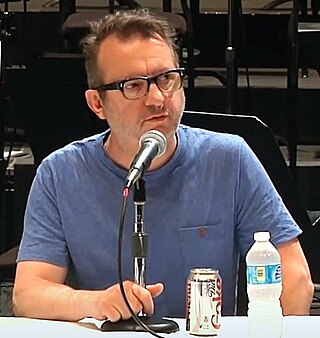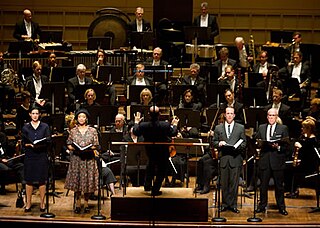Related Research Articles

Mark-Anthony Turnage is an English composer of contemporary classical music.

Esa-Pekka Salonen is a Finnish conductor and composer. He is the music director of the San Francisco Symphony and conductor laureate of the Los Angeles Philharmonic, Philharmonia Orchestra in London and the Swedish Radio Symphony Orchestra. In 2024, he announced his resignation from the San Francisco Symphony upon the expiration of his contract in 2025.

Steven Edward Stucky was a Pulitzer Prize-winning American composer.
Polish composer Witold Lutosławski wrote his Symphony No. 4 in 1988–92, completing it on 22 August 1992.
The Violin Concerto is the only violin concerto by the Finnish conductor and composer Esa-Pekka Salonen. It was finished in 2009 and has become one of Salonen's major works.
Symphony No. 1 is a symphony in one movement by the American composer Christopher Rouse. The work was commissioned by David Zinman and the Baltimore Symphony Orchestra, completed on August 26, 1986, and premiered in Baltimore, January 21, 1988. The piece is dedicated to Rouse's friend and fellow composer, John Harbison.
The Flute Concerto is a concerto for flute and orchestra by American composer Christopher Rouse. The work was jointly commissioned by Richard and Jody Nordlof for flautist Carol Wincenc and by Borders Group for the Detroit Symphony Orchestra. It was completed August 15, 1993 and premiered on October 27, 1994 at Orchestra Hall in Detroit, with conductor Hans Vonk leading Carol Wincenc and the Detroit Symphony Orchestra. The piece's third movement is dedicated to the memory of James Bulger, an English toddler who was murdered in 1993 by two ten-year-old boys.
The Second Concerto for Orchestra is a concerto for orchestra by the American composer Steven Stucky. The work was commissioned by the Los Angeles Philharmonic while Stucky was their composer-in-residence for the inaugural season of the Walt Disney Concert Hall. It was completed in 2003 and was first performed on March 12, 2004, with the conductor Esa-Pekka Salonen leading the Los Angeles Philharmonic. The piece was awarded the 2005 Pulitzer Prize for Music.
L.A. Variations is an orchestral composition by the Finnish composer Esa-Pekka Salonen. The work was commissioned by the Los Angeles Philharmonic, of which Salonen was then music director. It was first performed at the Dorothy Chandler Pavilion in Los Angeles, on January 16, 1997, with Salonen conducting the Los Angeles Philharmonic. The piece is dedicated to the orchestra, about which Salonen remarked, "I wrote LA Variations specifically for the players of the Los Angeles Philharmonic. I'm very proud of the virtuosity and power of my orchestra."
The Concerto for Clarinet and Orchestra is a clarinet concerto in three movements by the American composer John Corigliano. The work was commissioned by the New York Philharmonic for the clarinetist Stanley Drucker. It was composed in the summer and fall of 1977 and was first performed in New York City on December 6, 1977, by Drucker and the New York Philharmonic conducted by Leonard Bernstein. The composition is dedicated to Drucker and Bernstein.
The Percussion Concerto No. 2 is a concerto for solo percussion and orchestra by the Scottish composer James MacMillan. The work was jointly commissioned by the Netherlands Radio Philharmonic, the Philharmonia Orchestra, the Orchestre national du Capitole de Toulouse, the Cabrillo Festival of Contemporary Music, the Baltimore Symphony Orchestra, and the São Paulo State Symphony. It was first performed on November 7, 2014 at TivoliVredenburg in Utrecht, the Netherlands, by percussionist Colin Currie and the Netherlands Radio Philharmonic under conductor James Gaffigan. The composition is MacMillan's second percussion concerto after 1992's Veni, Veni, Emmanuel.
The Concerto for Orchestra is an orchestral composition by the American composer Joan Tower. The work was jointly commissioned by the St. Louis Symphony, the Chicago Symphony Orchestra, and the New York Philharmonic.
The Concerto for Clarinet is a composition for solo clarinet and orchestra by the American composer Joan Tower. The work was commissioned by the Walter W. Naumburg Foundation for the clarinetist Charles Neidich, to whom the piece is dedicated.
Interventions is a composition for solo piano and orchestra by the American composer Elliott Carter. The work was composed at the behest of the pianist Daniel Barenboim and the conductor James Levine to celebrate Carter's 100th birthday. The piece was completed on April 16, 2007 and was first performed in Symphony Hall, Boston on December 4, 2008 by Daniel Barenboim and the Boston Symphony Orchestra under James Levine.
The Pied Piper Fantasy is a concerto for flute and orchestra by the American composer John Corigliano. The work was commissioned by the flutist James Galway and it is based on the tale of the Pied Piper of Hamelin. The piece was given its world premiere by Galway and the Los Angeles Philharmonic under the conductor Myung-whun Chung at the Dorothy Chandler Pavilion on February 4, 1982. In 1993, the critic Mark Swed of the Los Angeles Times described it as "one of the best known of modern American concertos."
The Concerto for Cello and Orchestra is a cello concerto by the Polish composer Witold Lutosławski. The work was commissioned by the Royal Philharmonic Society with support from the Calouste Gulbenkian Foundation. It received its world premiere at the Royal Festival Hall on October 14, 1970 by the cellist Mstislav Rostropovich and the Bournemouth Symphony Orchestra under the direction of Edward Downes.
The Double Concerto for Violin, Violoncello, and Orchestra is a 2014 composition by the German-American composer André Previn. The work was co-commissioned by the Cincinnati Symphony Orchestra and Linton Music with financial support from Ann and Harry Santen. It was additionally commissioned by the Austin Symphony Orchestra, the Detroit Symphony Orchestra, the Deutsche Kammerphilharmonie Bremen, the Kansas City Symphony, the Pacific Symphony, the Swedish Chamber Orchestra, and the Toronto Symphony Orchestra. The world premiere was given by the husband/wife duo of the violinist Jaime Laredo and the cellist Sharon Robinson with the Cincinnati Symphony Orchestra under the direction of Louis Langrée in Cincinnati on November 21, 2014. The concerto is dedicated to Jaime Laredo and Sharon Robinson.
The Concerto for Viola and Orchestra is a viola concerto by the American composer John Harbison. The work was commissioned by the Saint Paul Chamber Orchestra, the Los Angeles Chamber Orchestra, and the New Jersey Symphony Orchestra with contributions from Meet The Composer and Reader's Digest. It was first performed by Jaime Laredo and the New Jersey Symphony Orchestra under the direction of Hugh Wolff on May 18, 1990.
The Concerto for Piano and Orchestra is a composition for solo piano and orchestra by the Polish composer Witold Lutosławski. The music was commissioned by the Salzburg Festival. It was first performed at the festival on August 19, 1988 by the pianist Krystian Zimerman and the Austrian Radio Orchestra under the direction of the composer. Lutosławski dedicated the piece to Zimerman.
The Concerto for English Horn and Orchestra is a composition for solo English horn and orchestra by the American composer Ned Rorem. The work was commissioned by the New York Philharmonic to commemorate the orchestra's sesquicentennial anniversary. It was first performed by the soloist Thomas Stacy and the New York Philharmonic under the direction of Kurt Masur at Avery Fisher Hall on January 27, 1994. Rorem dedicated the piece to Thomas Stacy. The work is one of the few prominent contemporary English horn concertos, along with James MacMillan's The World's Ransoming.
References
- 1 2 Stucky, Steven (1994). Concerto for Two Flutes and Orchestra: Program Note by the Composer. Retrieved March 22, 2016.
- 1 2 Mangan, Timothy (February 25, 1995). "Music And Dance Reviews : L.A. Philharmonic Ventures Finnish American Program". Los Angeles Times . Retrieved March 22, 2016.
- ↑ Cariaga, Daniel (February 26, 1995). "MUSIC & DANCE NEWS : From USC to Music Center". Los Angeles Times . Retrieved March 22, 2016.